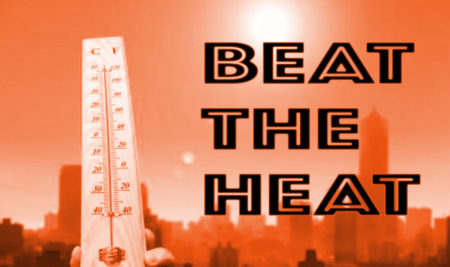As the temperatures rise and deadlines loom, keeping your workers cool and comfortable helps to keep everyone productive and safe. Heat Stress is one of the many seasonal dangers that can have serious consequences if not checked. In 2014, the CDC reported 20 cases of heat-related on-the-job illnesses, 13 of which resulted in the death of a worker. It doesn’t have to be this way; knowing how to identify the symptoms of Heat Stress can help workers and employers create a game plan to beat the heat.
Heat Stress & Employer Responsibility
In the decade between 2001 – 2010, over 28,000 people were hospitalized due to illnesses resulting from Heat Stress. Although the warmer weather typically goes hand in hand with more work; we often forget that we still must keep each other safe. While OSHA hasn’t prescribed a set “maximum safe temperature” for workers, employers are still required to provide safe working environments for their employees.
In the U.S., enforcement against employers has typically been warranted under Section 5 – General Duty Clause; “[an employer] shall furnish to each of his employees, employment and a place of employment which are free from recognized hazards.” Heat Stress and heat-illness are both considered recognized hazards and should be considered when creating a safety plan for your job site.
Identifying Heat Stress Symptoms
When we looked at the impact of cold-related deaths and injuries earlier this year, we noticed that too often symptoms of a bigger threat were often ignored or simply not known. Unfortunately, although we recognize Heat Stress as a job hazard many times we ignore the symptoms before they spiral out of control. Being able to identify the symptoms of the three primary forms of Heat Stress and heat-illness are key to responding quickly but more importantly, help prevent it altogether.
Heat Cramps – are usually the result of performing hard labor in a hot environment. Heat cramps are often attributed to an electrolyte imbalance due to profuse and prolonged sweating which robs the body of salts and water. Symptoms include muscle cramps, muscle pain, or muscle spasms in the abdomen, arms, and/or legs.
Heat Exhaustion – is often confused for lethargy but can be very dangerous on a job site. As one of the symptoms of heat exhaustion is dizziness and risk of fainting, the dangers of heat exhaustion are worsened when workers are operating machinery. Some other symptoms include profuse sweating, extreme weakness and fatigue, nausea, vomiting, and elevated body temperatures.
Heat Stroke – is the most critical and directly, life-threatening form that Heat Stress takes on. Heat stroke is a medical emergency that occurs when the body is unable to control its temperature. If not immediately treated, victims can suffer permanent disability or death. The signs to look out for are high body temperature, confusion and loss of coordination, hot, dry skin or profuse sweating, throbbing headaches, seizures or coma.
Battling Heat Stress
As always prevention is the best course of action when dealing with workplace hazards but if one of your workers finds themselves suffering from any of the symptoms listed above, you can take immediate steps to help prevent further or sustained injury. For starters, if a worker is experiencing any kind of dizziness or extreme fatigue they should immediately cease heavy labor and be moved to an area with a fan or air conditioning to prevent their condition from worsening. It should be noted that if the worker has stopped sweating but continues to exhibit the signs of Heat Exhaustion or the beginnings of Heat Stroke, placing them in an area where there’s more air flowing won’t be enough to get them out of harm’s way. Once a person has stopped being able to sweat, their natural cooling mechanism ceases to properly function and are in danger of serious injury due to Heat Stress. In this case, you’ll want to immediately douse them in ice water and move them to an air-conditioned room.
Related Courses: 30-Hour OSHA Construction Safety & Health Training
There are preventative measures you should also consider. For one, creating a buddy system for workers that will be doing hard labor in the open heat will help keep tabs on one another and ensure that they are properly hydrated and not over exerting themselves. Getting prepped for the heat is another way to beat the dangers of Heat Stress. Taking a page from the U.S. Army Rangers & Airborne’s Heat Acclimatization Guide (PDF), you can become heat acclimated by doing cardio exercises in the heat for two weeks prior to build up a tolerance to the extreme demands the heat and your work places on your body.
Employers and site safety managers should include intermittent periods of extended rest in their safety plans in preparation for the dog days of summer. Employers should also consider rotating work duties and locations, especially if there are extreme heat conditions – keeping your workers safe keeps you on schedule.
As the summer continues to heat up and we spend more time on the job getting things done remember to keep you and your team safe. As the seasons change our site safety plans must as well; workers should also be mindful of how the change in climate affects their ability to work. By taking the time to prepare we can all see a productive summer without injuries or deaths.

